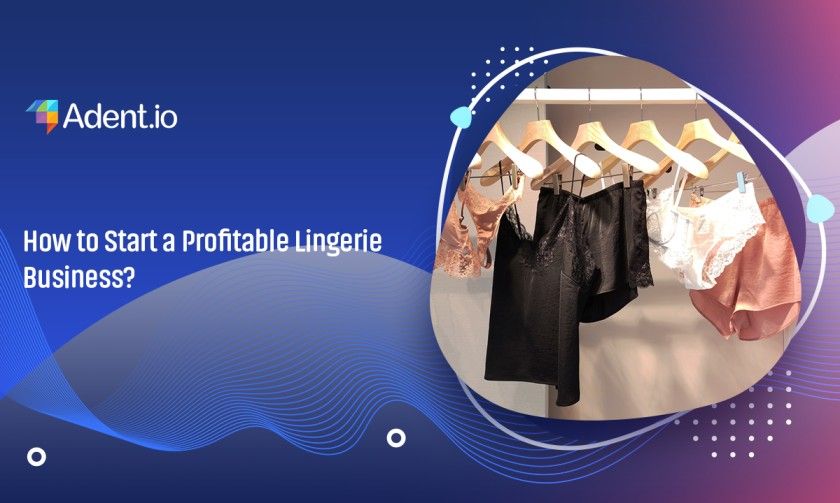Starting a lingerie business opens the door to endless creative possibilities – but it also comes with its fair share of challenges. With consumer preferences shifting toward inclusivity, sustainability, and unique designs, entrepreneurs have a chance to create brands that truly connect with modern shoppers. However, standing out in a highly competitive market requires more than just great products – it demands innovation, authenticity, and a strong brand identity.
From defining your target audience to building a standout brand in the fast-paced digital world, the road to success can feel overwhelming. In this guide on ‘How to start a lingerie business’, we’ll walk you through the essential steps to get started, helping you tackle pain points and offering actionable steps for overcoming them in the loungewear industry and beyond.
Lingerie Business: Is It Profitable or Not?
The short answer: Yes, but like any business, it depends on how you approach it. Let’s break it down and explore the profits, challenges, and key factors that influence success in the lingerie market.
Market Growth and Revenue
The global lingerie market was valued at a staggering $88.32 billion in 2022 and is projected to grow at a strong CAGR of 5.7% from 2023 to 2030. This impressive growth is driven by increasing consumer demand and the rise of e-commerce.
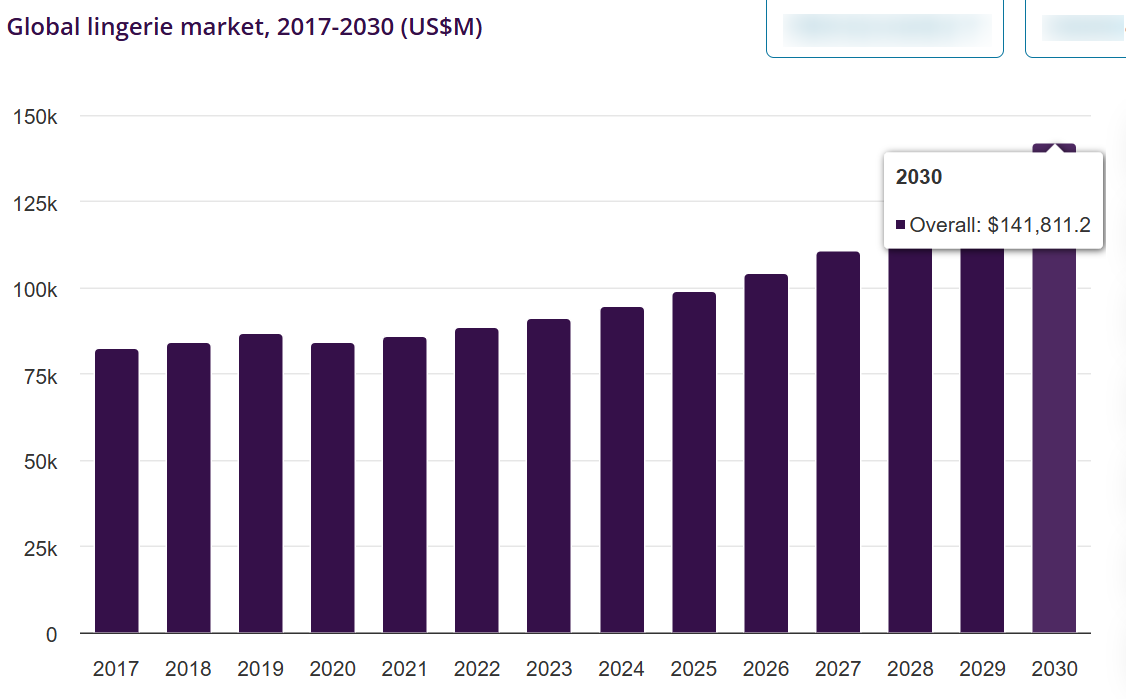
Notably, the online lingerie sector alone was worth $40.4 billion in 2022 and is set to grow at an even higher CAGR of 6.5% through 2031. These numbers underscore a significant opportunity for businesses leveraging online platforms effectively to tap into this thriving and highly profitable market.
Earnings for Business Owners
Owners of small to medium-sized lingerie stores typically earn between $55,000 – $80,000 annually, which corresponds to about 10% -15% of gross revenue. Larger chain stores can report significantly higher incomes, often between $80,000 and over $150,000, due to economies of scale and brand recognition.
Boutique shops, while potentially earning less in total revenue, often enjoy higher profit margins ranging from 10% to 20% due to their unique offerings and personalized service.
How To Start a Lingerie Business?
Starting a lingerie business combines fashion, comfort, and entrepreneurship. From market research to manufacturing and sales, this guide will walk you through the key steps to launching a successful lingerie brand.
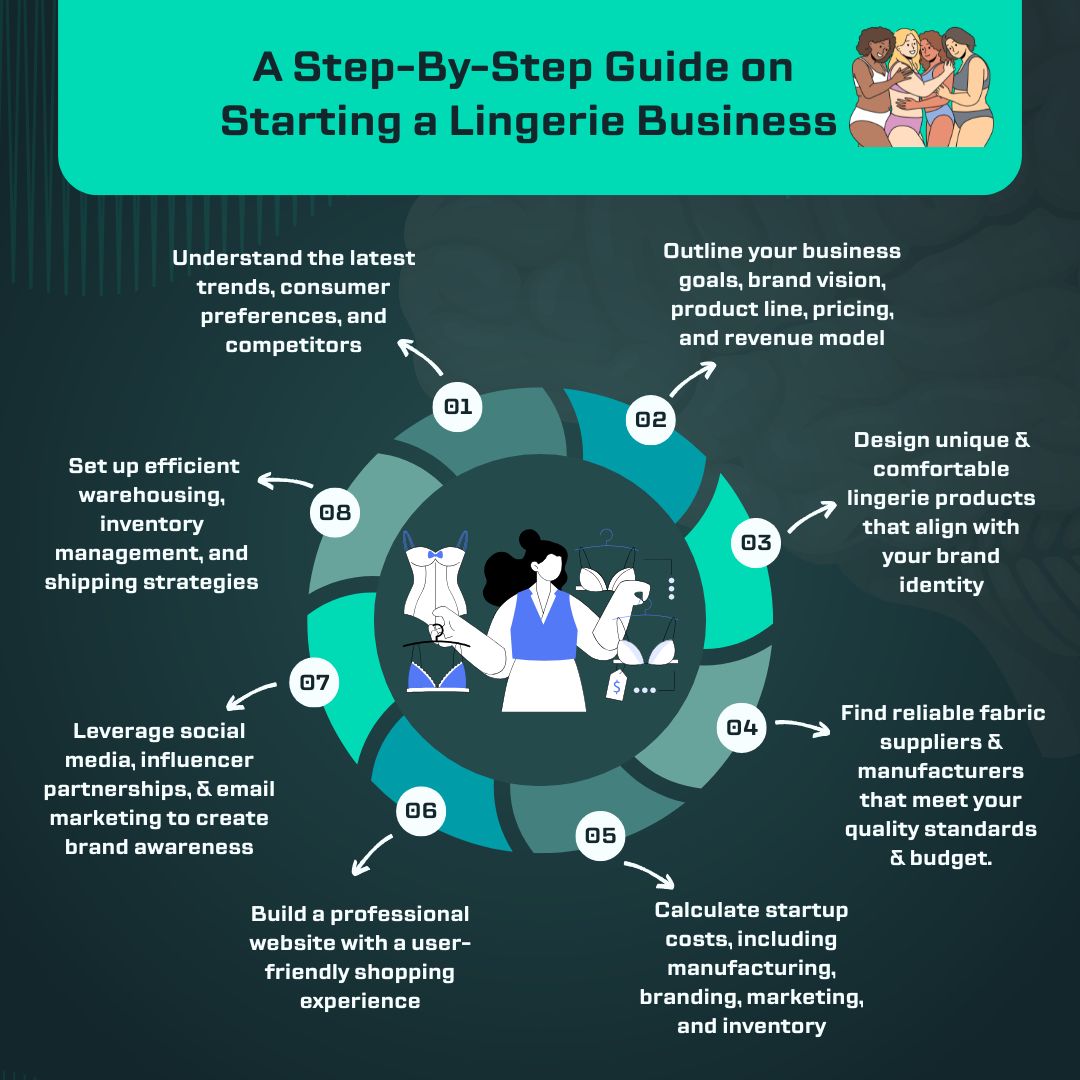
1. Research the Lingerie Market
Before launching any business, it’s critical to understand the industry you’re entering. The lingerie market is vibrant and ever-evolving, with growing demand across various segments, including everyday wear, luxury lingerie, plus-size options, and sustainable designs. Conducting in-depth market research helps you gauge the current trends, customer preferences, and your competition, setting the stage for success.
Key Aspects of Market Research:
- Target Audience:
Who are your customers? Are you targeting luxury buyers, budget-conscious shoppers, or perhaps a niche market like eco-friendly lingerie enthusiasts? Understanding your target demographic -age, income, lifestyle, and preferences, is key to tailoring your offerings. - Market Trends:
Trends in lingerie can change quickly. For instance, there has been a growing demand for comfortable, non-wired bras, loungewear, and inclusive sizing. Stay up to date with the latest developments and shift your product offerings accordingly. Sustainability is another key trend, with eco-conscious consumers opting for ethically produced lingerie. - Competitor Analysis:
Research your competitors to see what they’re doing right and where there’s room for improvement. Look at the major players like Victoria’s Secret, Aerie, and smaller, independent brands. What are their price points? How do they market their products? What’s their USP? Identifying gaps in the market will help you position your brand effectively. - Supplier Research:
Identify reliable suppliers for fabrics, packaging, and manufacturing. It’s essential to find partners who can provide high-quality materials at competitive prices while meeting ethical production standards.
2. Create a Business Plan
When starting a lingerie business, there are several critical components to cover, including the legal considerations necessary to protect your brand and ensure compliance with industry regulations.
Key Components of a Lingerie Business Plan:
A well-structured lingerie business plan is essential for turning your vision into a profitable reality. Start with an executive summary – though written last, it should be a compelling snapshot of your business concept, mission, goals, and strategy. The business description defines your niche: Are you focusing on luxury, comfort, or sustainability? Will you sell online, in physical stores, or both?
A thorough market analysis will help you understand industry trends, competitors, and target customers, while a detailed products & services section should outline your offerings – bras, panties, loungewear, or even custom and subscription services. Your sales and marketing strategy should highlight how you’ll attract customers, from influencer partnerships to SEO and paid ads.
Finally, a solid financial plan will ensure profitability, covering startup costs, pricing models, and revenue projections. With a clear roadmap, your lingerie brand can stand out in a competitive market and thrive.
Legal Considerations:
Alongside the business plan, you must address legal requirements to ensure your lingerie business operates smoothly and legally. These steps include choosing the right legal structure, protecting your intellectual property, and understanding tax obligations.
Choosing the right business structure is a crucial first step. Whether you operate as a sole proprietorship, LLC, or corporation, each comes with different tax, liability, and administrative responsibilities. Many small businesses opt for an LLC as it offers liability protection with less complexity than a corporation.
Next, register your business with the appropriate state or local authorities, and secure a domain name and professional business email for your online presence. Protect your brand by filing for trademarks and copyrights to safeguard your logo, business name, and unique designs.
Compliance with product safety standards is essential, particularly for shapewear or sleepwear, so check relevant regulations like those enforced by the Consumer Product Safety Commission (CPSC) in the U.S. Additionally, if you’re selling online, stay informed about sales tax requirements and e-commerce regulations, which vary by region. Understanding these legal and financial aspects ensures your lingerie business operates smoothly while minimizing risks.
3. Product Development
Product development is where your lingerie business truly begins to take shape. This step involves designing your lingerie line, choosing materials, creating prototypes, and refining your products until they’re ready for production. A well-thought-out product development strategy will set you apart from competitors and help you build a brand that resonates with your target audience.
Key Aspects of Product Development:
Defining your product range is the first step in building a successful lingerie brand. Will you offer bras, panties, shapewear, loungewear, or sleepwear? Consider whether your niche will focus on sustainability, luxury, or size inclusivity. A clear vision aligned with your brand and target audience is key.
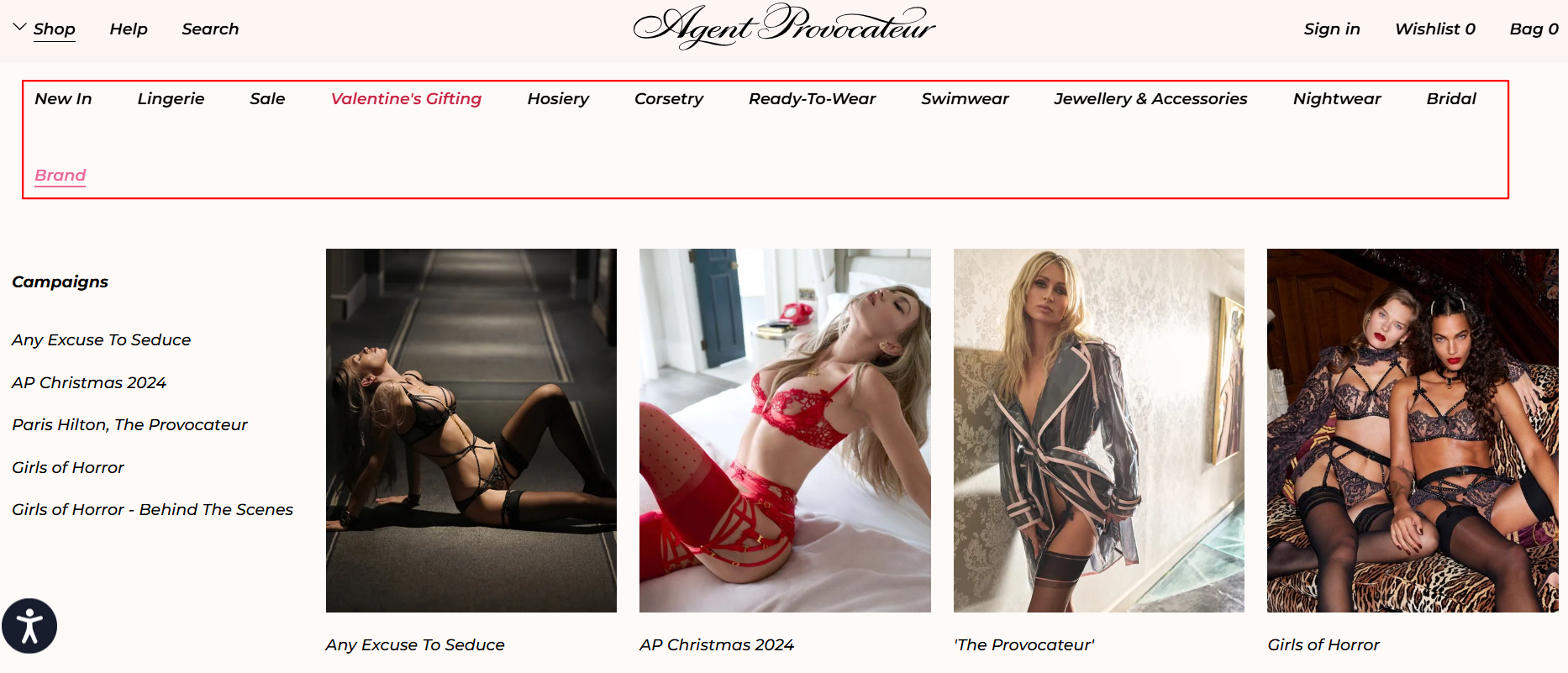
Next, develop a unique selling proposition (USP) – what sets your lingerie apart? Whether it’s exceptional comfort, inclusive sizing, or eco-friendly fabrics, a strong USP will help you stand out in a crowded market. Once your concept is refined, move to design and prototyping by working with professionals or designing in-house. Selecting high-quality fabrics, refining fit, and creating prototypes ensures your lingerie meets both aesthetic and functional expectations.
Quality & fit are crucial -lingerie should be stylish, durable, and flattering across various body types. If catering to plus-size or petite markets, precise tailoring is essential. Packaging and branding also play a major role, especially for premium brands; consider eco-friendly options to appeal to sustainability-conscious consumers.
Before launching, conduct testing and feedback sessions with your target audience. Gather insights on comfort, fit, and style to make final adjustments. By refining each step, you’ll create a lingerie line that not only looks great but also resonates with customers.
4. Sourcing and Manufacturing
Once you’ve finalized your product designs, the next step is sourcing materials and finding a manufacturer to bring your lingerie line to life. This process requires careful attention to ensure high-quality production and timely delivery while staying within budget.
Key Aspects of Sourcing and Manufacturing:
Selecting the right materials is essential for creating high-quality lingerie. Fabrics like cotton, silk, satin, lace, microfiber, and spandex define comfort, durability, and aesthetics. If sustainability is a priority, explore eco-friendly options such as organic cotton, recycled fabrics, or bamboo. Always request samples from textile suppliers to evaluate softness, elasticity, and long-term wearability before committing to bulk orders.
Finding the right manufacturer is equally crucial. Domestic manufacturers offer better quality control and faster turnaround times, but they can be costly. Overseas manufacturers, particularly in China, India, and Bangladesh, provide lower costs but require careful attention to logistics and quality assurance. If you’re launching a boutique brand, small-batch manufacturers can offer flexibility for limited-edition or handmade designs. Always assess a manufacturer’s expertise, reliability, and production capacity – visiting facilities or requesting samples can help ensure they meet your standards.
Understanding production costs and minimums is key. Some manufacturers require high order volumes, which can lower per-unit costs, but small businesses may benefit from low minimums to test the market. Negotiating pricing while balancing quality is essential.
Quality control ensures consistency in your lingerie line. Implement inspections at different production stages, review samples, or use third-party auditors to maintain high standards. Lastly, prioritize ethical sourcing and fair labor practices by choosing manufacturers that comply with labor laws and sustainability certifications like Fair Trade or GOTS. Responsible production strengthens your brand’s reputation and also aligns with conscious consumer preferences.
5. Financial Planning and Funding
Financial planning is essential for the successful launch of your lingerie business. Startup costs can vary widely based on factors such as location, business model, and scale. Here’s a breakdown of typical expenses you might incur:
| Aspect of Financial Planning | Estimated Costs (USD) | Key Insights/Examples |
| 1. Business Registration & Licensing | $500–$2,000 | Costs vary by country; online registration is typically more affordable |
| 2. Product Development | $3,000–$30,000+ (depending on scale) | High-end lingerie brands like Savage X Fenty prioritize premium quality fabrics. |
| 3. Inventory & Stock | $5,000–$30,000 | Opt for small batches initially to manage risks and storage costs. |
| 4. Branding & Packaging | $2,000–$10,000 | Example: Victoria’s Secret is known for its luxurious branding that attracts premium customers. |
| 5. E-commerce Platform Development | Variable | Consider using e-commerce scripts like xMarketplace by Adent.io for seamless integration and functionality. |
| 6. Marketing & Advertising | $3,000–$12,000+ (monthly) | ThirdLove leverages personalized marketing to engage customers. |
| 7. Logistics & Fulfillment | $2,000–$10,000+ (monthly) | Partner with logistics services like DHL or ShipBob for streamlined operations. |
6. E-commerce
In today’s digital age, having a robust online presence is crucial for any retail business. Here’s how to effectively set up your e-commerce platform:
- Website Development: Invest in a user-friendly e-commerce website. Costs can range from $5,000 to $15,000, depending on the complexity of the site. Ensure it includes essential features like product categories, secure payment options, and customer reviews.
- Inventory Management System: Implement an inventory management system that integrates with your e-commerce platform. This will help track stock levels and streamline operations.
- Customer Engagement: Use social media platforms like Instagram and Facebook to engage with customers. Share content that resonates with your target audience and showcases your products.
Offline Presence
While e-commerce is vital, don’t underestimate the value of an offline presence:
- Retail Space: If you opt for a physical store, consider locations with high foot traffic. The rent can vary significantly based on location; expect to pay between $2,000 and $10,000 per month depending on size and area.
- Pop-Up Shops: Consider starting with pop-up shops or participating in local markets to test your products without committing to long-term leases.
- Community Engagement: Host events or workshops related to lingerie fitting or styling to build community ties and attract customers.
7. Marketing and Sales Strategies
Successfully marketing and selling your lingerie is all about understanding your target audience, differentiating your brand, and creating a strong emotional connection with customers. Here are some essential strategies to consider:
Social Media Marketing:
Social media platforms like Instagram, Facebook, and TikTok are powerful tools for promoting lingerie brands, especially with their emphasis on visual content. High-quality imagery and user-generated content (like real customers wearing your products) can drive engagement and build trust. Instagram Stories and Reels, influencer collaborations, and paid ads are great ways to attract attention.
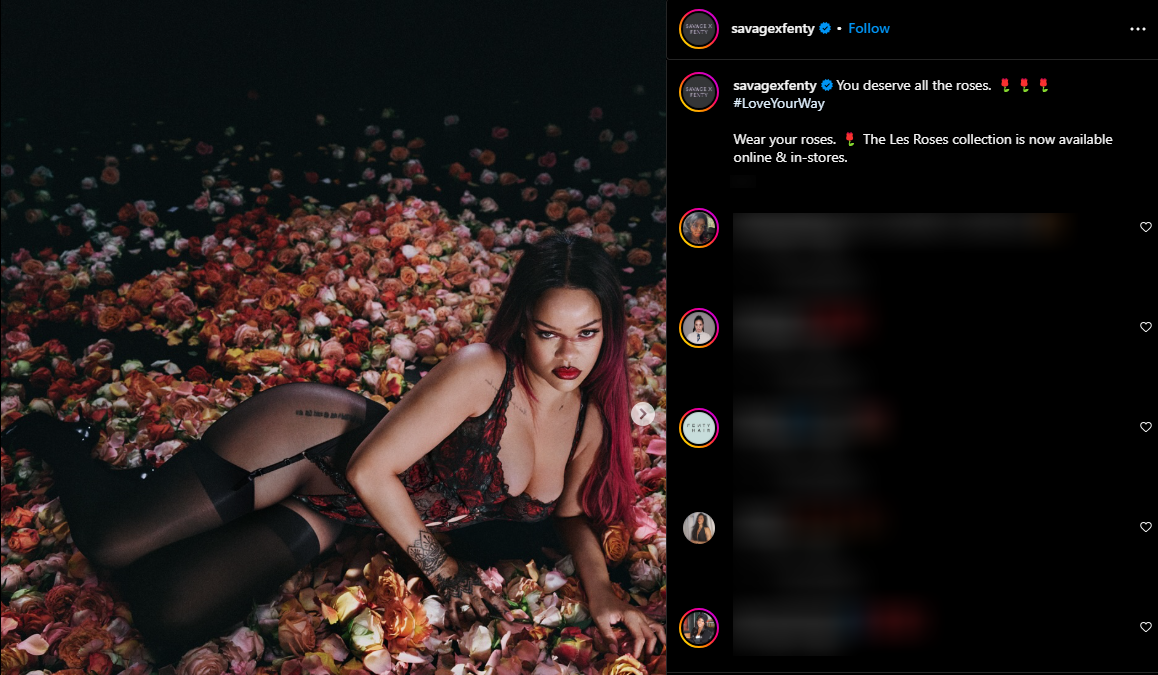
Influencer Marketing:
Collaborating with influencers who align with your brand values is an excellent way to expand your reach. Whether they’re micro-influencers with smaller but dedicated followings or well-known celebrities, influencer marketing can generate buzz, credibility, and sales for your brand.
Search Engine Optimization (SEO):
Ensuring that your website ranks high in search results is essential for driving organic traffic. Invest time in optimizing product pages, blog posts, and metadata. Keywords like “best luxury lingerie,” “affordable intimate apparel,” or “comfortable bras for all sizes” can attract potential customers.
Email Marketing:
Email is an effective way to communicate with your customers directly. Build an email list by offering discounts or exclusive content in exchange for signing up. Use emails to announce new products, special promotions, or seasonal sales. Personalize your emails based on past purchases to enhance customer retention.
Content Marketing:
Content like blogs, lookbooks, and tutorials can position your brand as an expert in the lingerie field. Offer valuable content related to lingerie care, sizing guides, styling tips, or the latest trends to keep your audience engaged and informed.
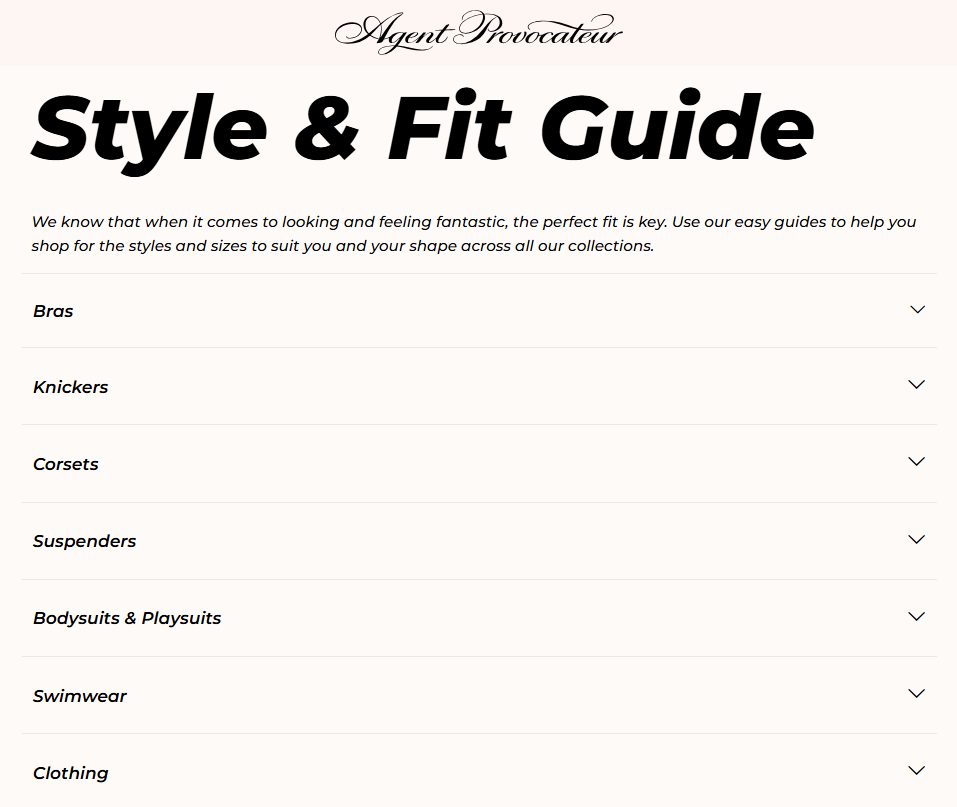
Referral and Loyalty Programs:
Building a customer base that returns frequently is crucial for long-term business success. Implementing a referral program incentivizes customers to spread the word about your brand. A loyalty program that rewards customers for repeat purchases can also drive sales and enhance customer loyalty.
Sales Strategies
- Pricing Strategy:
Pricing is critical in lingerie sales. Whether you opt for a premium pricing model, a mid-range model, or budget-friendly pricing, ensure it aligns with your brand’s identity and the target market. Pricing should reflect the quality and exclusivity of your products. - Bundling Products:
Offer discounts or promotions when customers purchase multiple items, such as a lingerie set (bra and panty combo). This encourages customers to buy more and increases your average order value. - Seasonal Sales and Promotions:
Use events like Black Friday, Valentine’s Day, and Christmas to offer special discounts or limited-edition lingerie. Creating urgency through flash sales or exclusive offers is a great way to drive quick sales.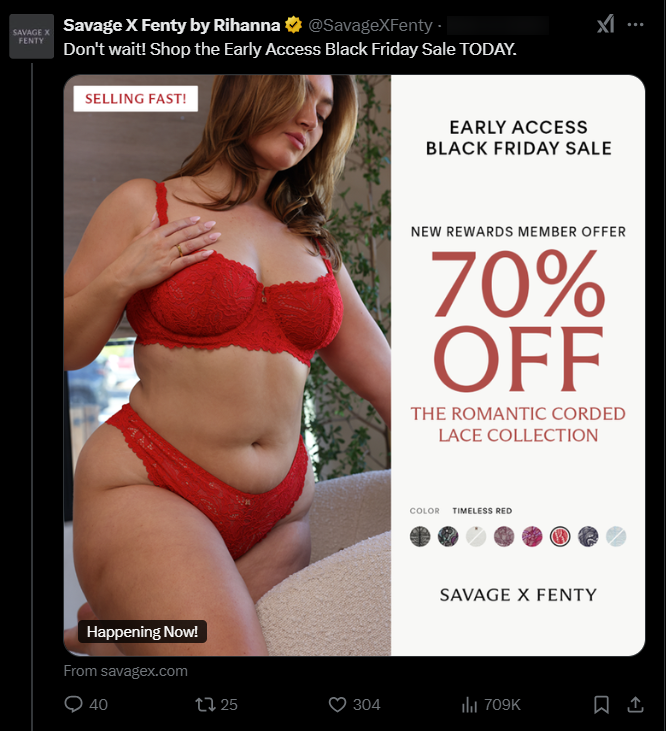
Black Sale Friday Sale Tweeted in by Savage X Fenty 4. Customer Reviews and Testimonials:
Positive reviews and testimonials can significantly influence potential buyers. Encourage satisfied customers to leave reviews and use those testimonials in your marketing materials.
8. Distribution and Logistics
Efficient distribution and logistics are key to ensuring your lingerie business runs smoothly and delivers a positive customer experience. Here’s what you need to consider when developing your distribution strategy:
Fulfillment and Shipping
- In-House Fulfillment vs. Outsourced Fulfillment:
- In-House Fulfillment:
Managing fulfillment in-house means you handle storage, packaging, and shipping. While this gives you more control over the process, it also comes with added complexity and overhead costs. You’ll need warehouse space, employees for packing, and shipping software for tracking and inventory management. - Third-Party Fulfillment (3PL):
Working with a third-party logistics provider can simplify fulfillment, especially as your business scales. 3PL companies handle everything from warehousing to packaging and shipping. Some popular 3PL services include ShipBob, Fulfillment by Amazon (FBA), or Shipwire.
- In-House Fulfillment:
- Shipping Options and Rates: Offering a variety of shipping options (standard, express, or international shipping) is crucial for customer satisfaction. You can also offer free shipping on orders over a certain value to encourage larger purchases. Make sure to negotiate with shipping carriers (like UPS, FedEx, or DHL) to get the best rates possible.
- Packaging: Lingerie products are delicate, so your packaging should reflect the quality of your brand while ensuring the product arrives safely. Use branded boxes, tissue paper, and eco-friendly materials to create a memorable unboxing experience. Sustainable packaging options are also a great selling point for eco-conscious consumers.
- Inventory Management: Proper inventory management is essential to prevent stockouts or overstocking. Use inventory management software to track sales, monitor stock levels, and manage reordering. Real-time tracking ensures that your distribution process remains smooth and efficient.
International Distribution
As your lingerie business grows, you may want to expand internationally. While selling internationally opens up new revenue streams, it also comes with additional complexities:
- Customs and Duties – Research the customs regulations and import duties of the countries you plan to ship to. These fees can affect both your pricing and the customer’s experience.
- International Shipping Partners – Work with reliable international couriers like DHL or FedEx to ensure timely deliveries. You may also need to consider regional shipping solutions depending on where you want to sell.
Returns and Exchanges
Returns and exchanges are inevitable in the retail business, but having a clear, customer-friendly returns policy is vital for customer retention. Since lingerie is intimate apparel, customers are more likely to return products that don’t fit well or aren’t exactly what they expected. Be transparent about your return policies and make the process as simple as possible.
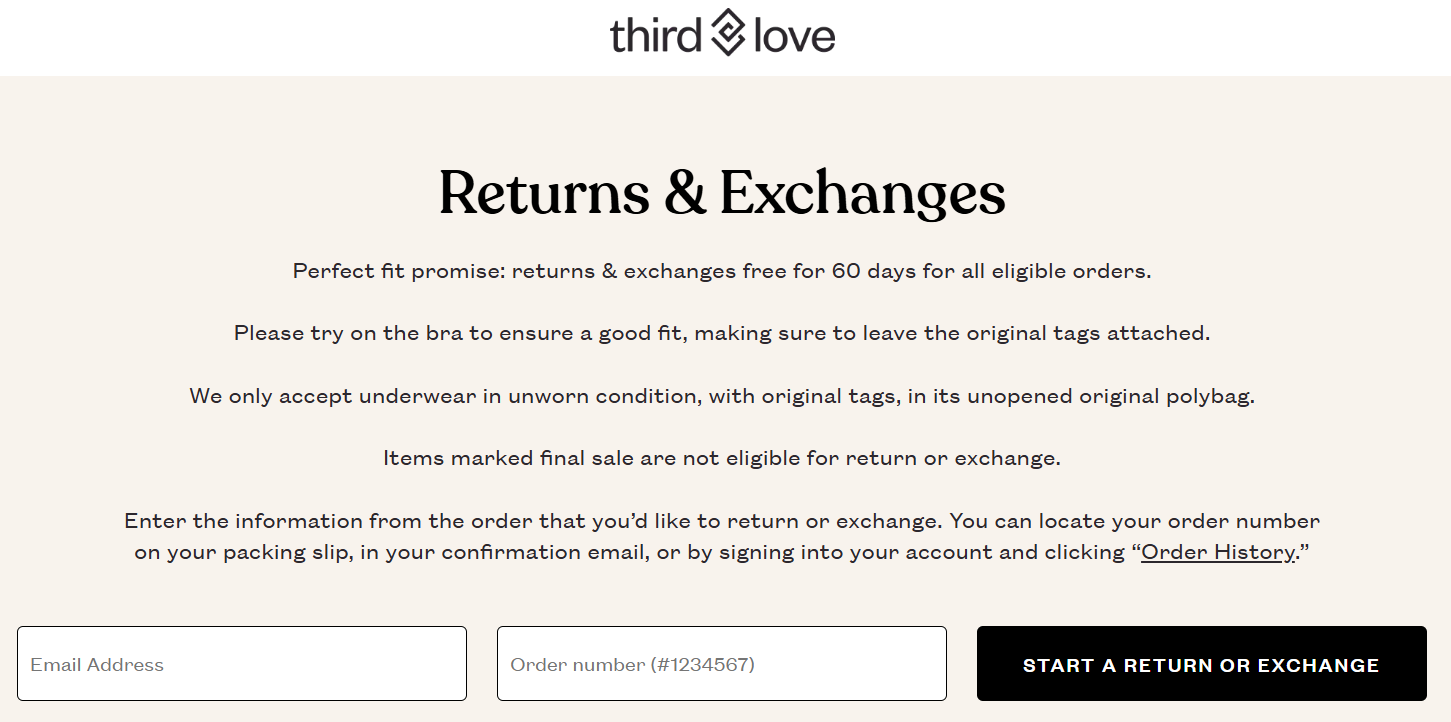
Offer free return shipping if possible, and make sure your returns are processed quickly to maintain customer trust. Consider using a “try-before-you-buy” service or offering virtual fit guides to reduce returns.
Final Words
By now, you’ve got a clear picture of how to start a lingerie business and bring your vision to life. Whether it’s choosing a unique niche, sourcing top-quality materials, creating stunning designs, or establishing a powerful online presence, each step is an opportunity to build a standout brand. The lingerie market thrives on creativity, quality, and genuine customer connection. With a focus on offering products that make people feel confident and comfortable, your business can make waves in this dynamic industry. Plus, ecommerce softwares like xMarketplace by Adent.io offer an excellent foundation for entrepreneurs, helping you seamlessly manage and expand your online store, connect with customers, and streamline operations. With passion, dedication, and the right tools, your lingerie business is bound to flourish!
Hi
Start Growing Your Dream Business
with Us!
Nathan
Head of Technical Support at Adent.io
Nathan leads Adent.io’s Technical Support team with a commitment to excellence, ensuring clients receive the help they need to succeed with their adult website platforms. A graduate of Chulalongkorn University with years of experience in technical support, Nathan combines his education with a deep understanding of Adent.io’s ready-made adult scripts, providing responsive, reliable assistance tailored to each client’s needs.

